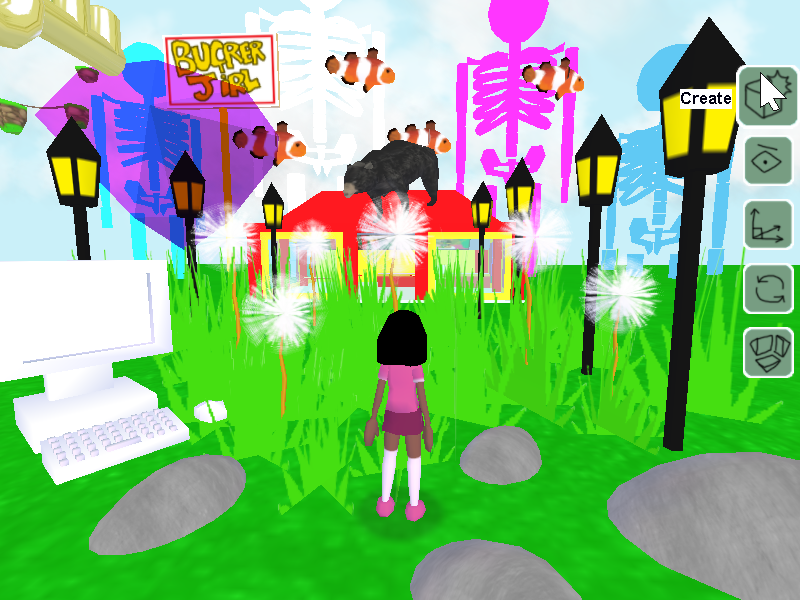
Here is an inspired find that’s… just… an amazing encapsulation of everything good about freeware tools.
Trust me. You need this one!
It’s a level editor of sorts, reminiscent of old school tools like Nickelodeon Director’s Lab, mixed with what feels like a very personal approach to what it means to create on a computer from the developer that made it.
“In KATELABS, Kate Barrett (Ready Player F**K, Flamingo Quest) brings you her most advanced tech yet… But with a twist! YOU get to be let loose with it! It’s a deep level editor with lots of features including moving platforms, rotating, scaling, paths, particles, and all sorts of other treats!
Can be used to make levels, or just to make art.”
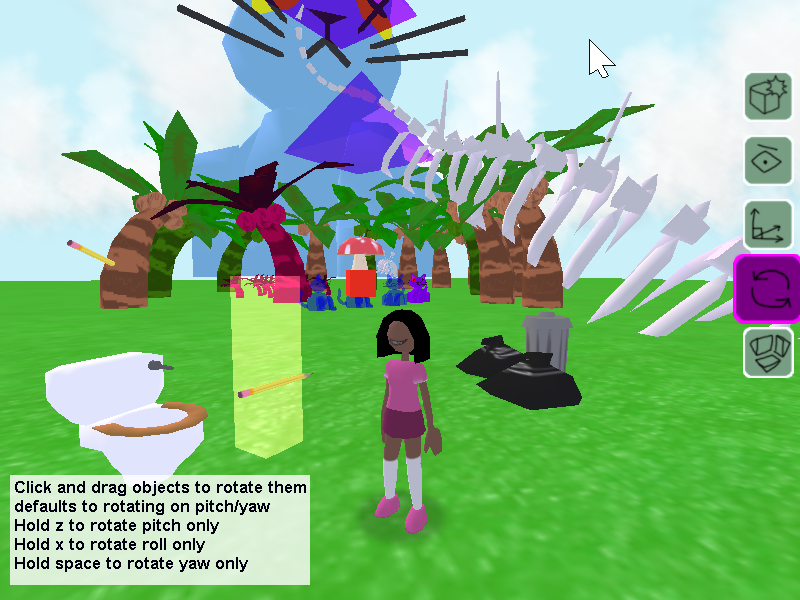
There’s a lot to unpack with this one. It’s this beautiful creative world in which you can make art using a variety of assets. There are movement capabilities too, so it becomes kind of like a 3D animation tool, meets game tool, meets a tiny story telling tool… I wouldn’t know where to begin. It’s amazing.
Katelabs is special because it captures something beautiful about tools that come from smaller devs. It’s a personal expression of what it means to be creative on a computer, as told to you by the developer.
Every dev that makes a tool has a different take on what it means to make art in the digital realm. What gets included, what gets focused on, how all that is expressed… Every tool from a smaller dev is different. Some focus entirely on professionalism and functionality, and then you occasionally find the really personal ones. The type of tool that’s not necessarily about being useful, but more about silly creative exploration.
These are the ones that I find really special. They kind of, in their own right, define what it means to be creative on a computer. Why does creating things on a computer need to be useful? Serve a commercial purpose? Be structured? What about the virtual playgrounds? These things that start existing based on a silly “what if”, or “wouldn’t it be cool if…” and they grow into their own type of very unique thing.
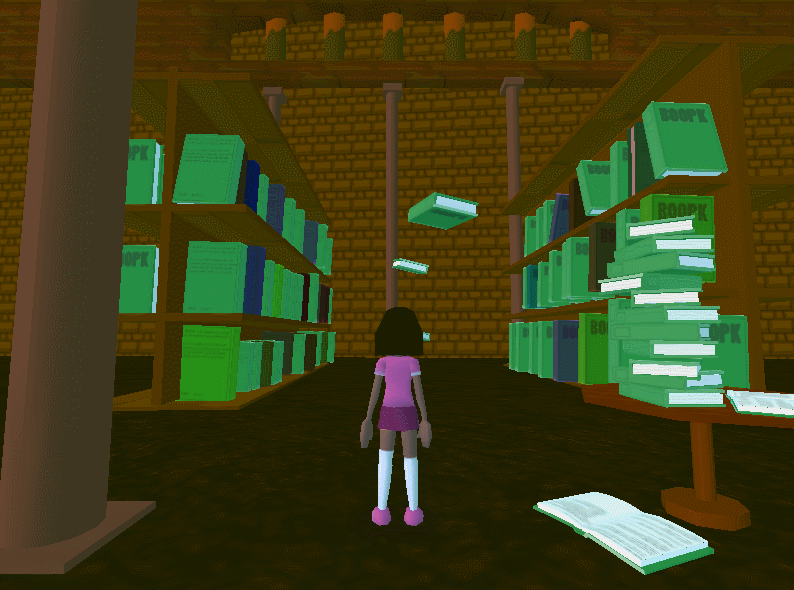
To me, Katelabs is all of that. It’s inspiring for how it encapsulates this almost “lost” playfulness when we think of digital tools. It’s more of a playground, yes, but it’s a really inspired one that lets you also make things that might end up being serious to you.
Katelabs places you in this empty space that you start populating with various objects, jellyfish, books, plains… and you give them life by applying basic things like movement to them. It quickly becomes this space to tell stories using this large assortment of assets.
I feel like I’m inventing vignettes when in it.
It reminds me a lot of things like Storybook Weaver, Elroy’s Costume Closet… It’s really inspired.
Katelabs is a generous tool that’s obviously personal to the developer. According to what I gather from the dev’s Tumblr the assets in Katelabs are from the dev’s own games.
It’s such a wonderful development. You can try it out for free from itch.
I start this post off by talking about Katelabs because I think making tools really gives you a different kind of perspective on what it means to use a computer… What it means to even create things on it.
Everything is ephemeral. Nothing really lasts. This thing of becoming outdated, technologies go extinct, lost to the cycles of progress… seems to be intrinsically built into computers.
The Electric Zine Maker will probably not live as long as some of the zines made in it that now exist in the real world. Who knows, maybe 10 years from now someone will find a worn out zine that was made in it, but you’ll likely not be able to run the actual software that far into the future. It’s just not how things work in the digital world.
I find myself looking at tools like LizardLadder and am kind of fascinated by how the digital outputs of it (the actual animations) will probably outlive the software itself.
When you make a tool it’s kind of like creating tiny waves, or echoes, through the ever forgetful historic timeline that is computer culture.
So like… Things like Katelabs are just… Amazing, strange, beautiful objects. You’ll create something specifically unique to it. Art that’s really specific to this one tool. Maybe tiny shadows of what you create in it will be remembered, the .gif’s will probably last longer than the saved level files, but the program itself is already a relic. It’s a special little thing, personal to the developer that made it, and just as personal to the user that’s creating in it.
You’re making art inside of someone else’s art.
This is why tool making on computers is such a fascinating space!
There are a lot of aspects of tool design that are interesting to think about. To me, they represent the ability to “invent” new types of art.
An example I keep going back to is kind of this pet-peeve I have when people making art tools spend so much time trying to “simulate” art tools in real life (watercolor, pencil textures…), when computers allow for completely unique new styles… Tool design is about exploring possibilities.
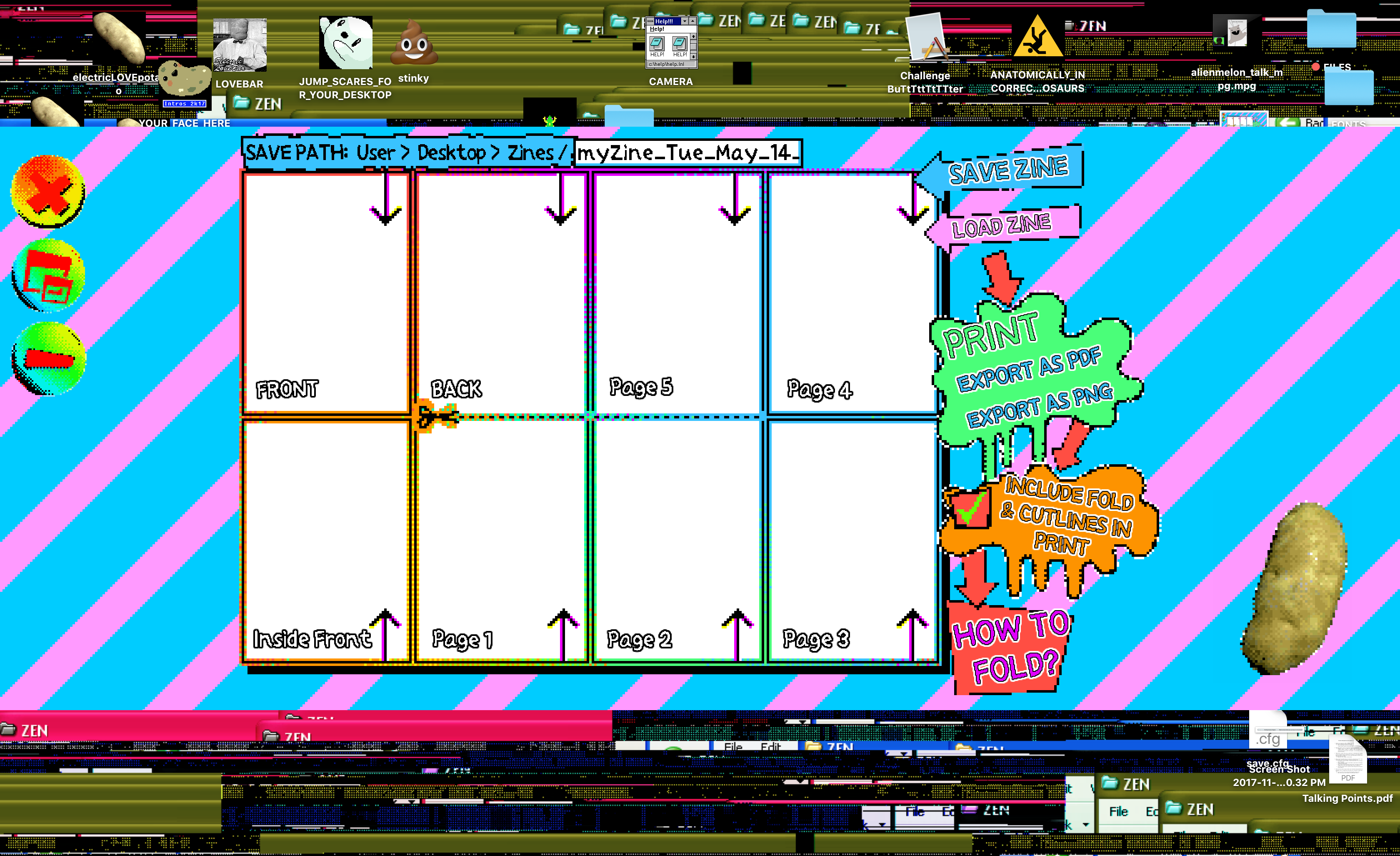
This is the thing that fascinates me about glitch art. Every technology has presented its own visual way of breaking. VCR gave us wobbly video, which gets throwbacks in movies sometimes. When film was first invented we got black and white grainy images… What I’m getting at with these examples is that all these are unique visual styles that we might not have had a concept of if it wasn’t for the invention of these “artistic technologies”.
Now we have these visual styles, and they get intentionally simulated or incorporated into artwork that “throws back” to that era. It’s part of a creative vocabulary now.
Glitchart is the same to me. It’s kind of like computers invent their own visual language when breaking. We have these really interesting textures, distortions, brokenness… that’s getting worked into a lot of indiegames to convey emotion.
Kind of like the PS1 aesthetic in the indie horror game boom happening on itch.
I REALLY don’t think it’s only about nostalgia, when we throw back to these visual styles. Saying “nostalgia” is my least favorite way to explain any of this. I think it’s so much more than nostalgia.
I think, when we do visual throwbacks, we explore what a visual style meant to us, and the direction we wished it might have evolved into. When a dev makes a PS1 aesthetic game, it’s also about dreaming of lost potential, speculation that never happened, exploring something unique to an era in a way that would not have been possible during that time. It’s a legitimate style the same way as modernism or cubism is… Maybe that’s pedantic, but look at it past “nostalgia” and it gets really interesting!
So when you make an art tool that intentionally incorporates these unique visual styles like glitchart, pixel art, computer distortions… It’s a way of letting people explore different types of expression not possible before.
I mean, when we paint with watercolor nobody is calling that “nostalgia” for a paper era? Why so quickly write off these techy visual styles as “nostalgia”? Say it about paper and pencil and see how it sounds! xD
Here are some good interesting examples of beautiful “glitchart” tools that I found lately…
DestroyPix is a glitch painting app for iOS and Android.
You load photos from your phone, and “paint” over them. The image distorts where you paint. It makes glitch art really accessible, and I love how it treats glitch literally as an art medium.
There are a lot of effects for it. It’s SUPER easy to use. I think it’s brilliant, and I value it for how accessible it makes glitch art. The glitching in this isn’t “uncontrollable” like how it is in most glitch approaches.
Glitch has always been based on randomized breaking. Maybe sliders… This one is so obviously tangible. You can make beautiful unique things with it. I can’t recommend it enough. It’s a really interesting one to dissect, and study.
When I made the Electric Zine Maker I wanted to make a tool that makes things like glitch accessible. One where you can just button mash and you’ll get interesting textures, colors, digital distortions… even ASCII art. The Electric Zine Maker lets you “paint” with a lot of things unique to computers. I find DestroyPix really inspiring because it’s even more specialized. Like just the idea of adding “artifacts” the same way that you would add spraypaint, is really inspiring. You need to try it!
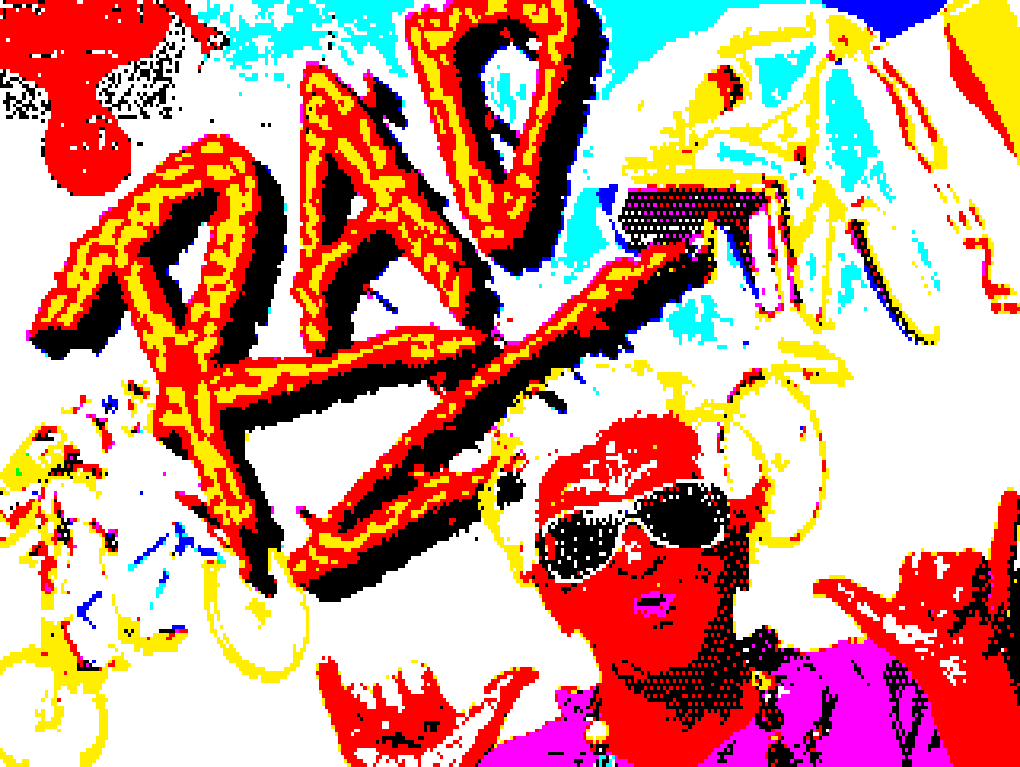
On the surface, Retromeme Generator is a simple image degradation tool. The way it degrades images tho is interesting to me. You have to manually place images that you want to import into the “Retromeme_Data/Managed” folder. They become available in the app. Once you open one, it imports it with the retro look applied, but you can move it around. It leaves behind some trailing effect if you move it, some little animated pixel bits are moving around it, and things are kind of drawing as you’re placing the image. It’s interesting for how little control you have, but still end up with a visually interesting thing. You add text in a simple way…
Overall, it’s a simple tool, but it’s fun to goof around in it. If you wouldn’t be making memes in it, you could actually make some interesting poetry or writing with it. The simplicity of it is what makes it fun.
(Note: Try it on Windows, the macOS version doesn’t really work?)
Things like Retromeme Generator or BECOME A GREAT ARTIST IN JUST 10 SECONDS feel like you’re co-authoring art with a computer. The uncontrollable nature of glitch, broken distorted pixels, artifacts… give you the impression that you’re trying to bend this unruly system to give you something interesting. Something intentional, while still being fundamentally unintentional.
Somewhere within the random brokenness of glitch you manage to pull out some beautiful happy accident.
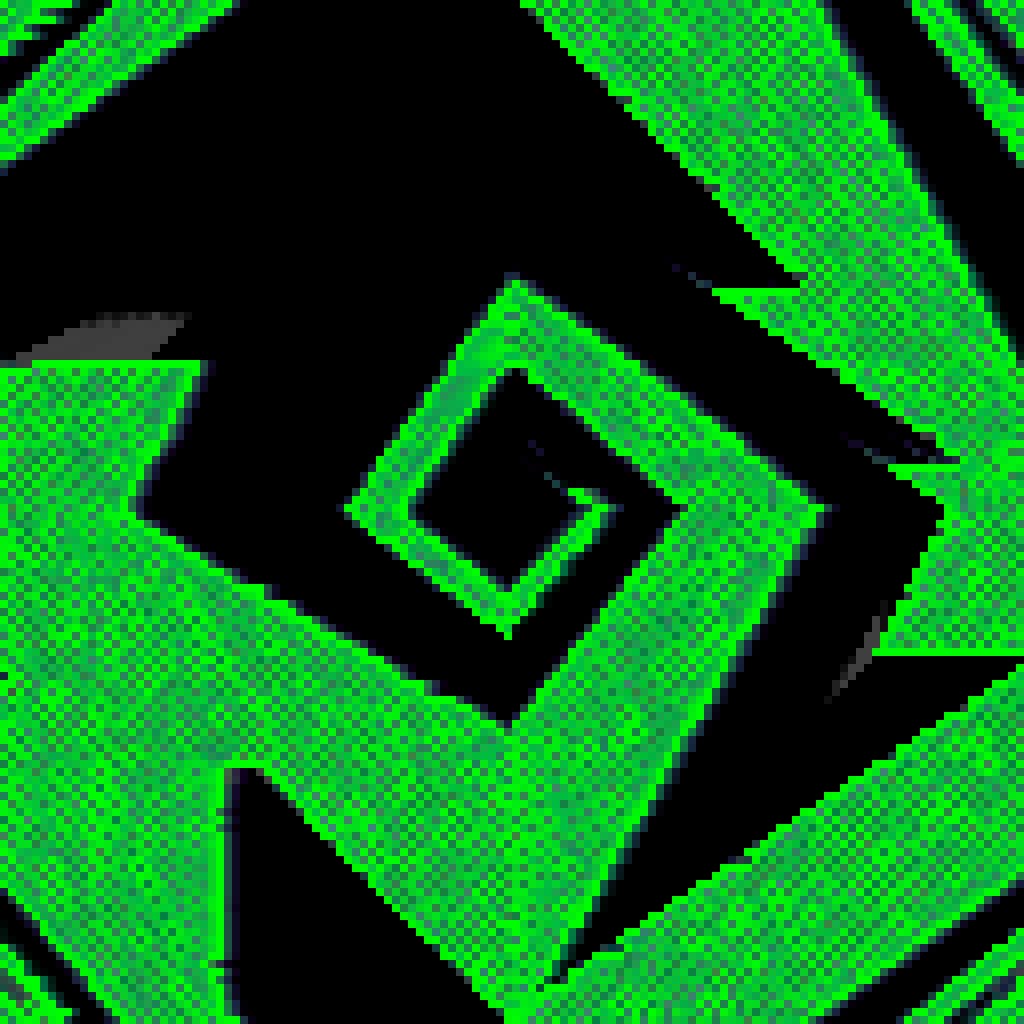
Image via the GreatArtist bot. Computer-generated art, updated four times a day
It’s something that I’m trying to capture with the Electric Zine Maker. Kind of give you a small snapshot of the uncontrolled playful aesthetics of computers… Seeing all the different ways that other devs do this… I don’t know if I’ve figured it out yet. Maybe the point is not to have it figured out, but it’s sure fun to let go of any sense of control and just see what beautiful thing you end up getting when you surrender control to the whims of the computer. :)
Channel Hopping by Mark Wonnacott is another beautiful example of that…
These things are like visualizers, but give you just enough control over it that you can discover art hidden inside all that random brokenness.
I know I get ridiculously poetic about glitch art, but (if you think about it) it kind of is ridiculously poetic.
It wouldn’t exist without computers. We wouldn’t even have a point of reference for understanding what it is, if it wasn’t for computers. Now we have all these really interesting queer art games that use glitch art to convey emotions, tension, distress… These indifferent broken electric signals suddenly become an emotional expression. It’s what art on computers is all about.
We discover new art tools, new ways of making art, not by intention but by accident. Many of the freeware tools by smaller devs that exist out there give me that impression.
A while ago the dev behind 1BITDRAGON emailed me, gifting me a copy of the tool.
“1BITDRAGON is a music creation software super easy to use, simple, instant and fun.
Create a basic melody in a few steps, compose a great song in a few minutes.”
I make mention of 1BITDRAGON here because it surprised me how easy it was to make something that sounded good without even knowing what I was doing. There are many options to it, it’s simplified so it’s not overwhelming, you “paint” to place the notes (like in a lot of music tools). I button mashed, but still got something that sounded impressive.
There are many music tools out there. 1BITDRAGON is one that simplifies it enough to make it welcoming to people that don’t understand the finer workings of music authoring.
I appreciate tools like this because all of them make something difficult accessible. I don’t need to be a programmer in order to know how to glitch an image. I don’t need to know music in order to make something that sounds good.
I mean, in essence, that’s why tools by smaller devs will always be relevant. “Big tools” are just that: too big… their size is scary, convoluted, too specific to market trends. The smaller tools let you explore new ideas. They open up creative things to you that you might not have known you even needed.
I use these weird glitch art tools in my games all the time.
So ok… I have a rant about zine culture and software that I wanted to get to too. Here we go…
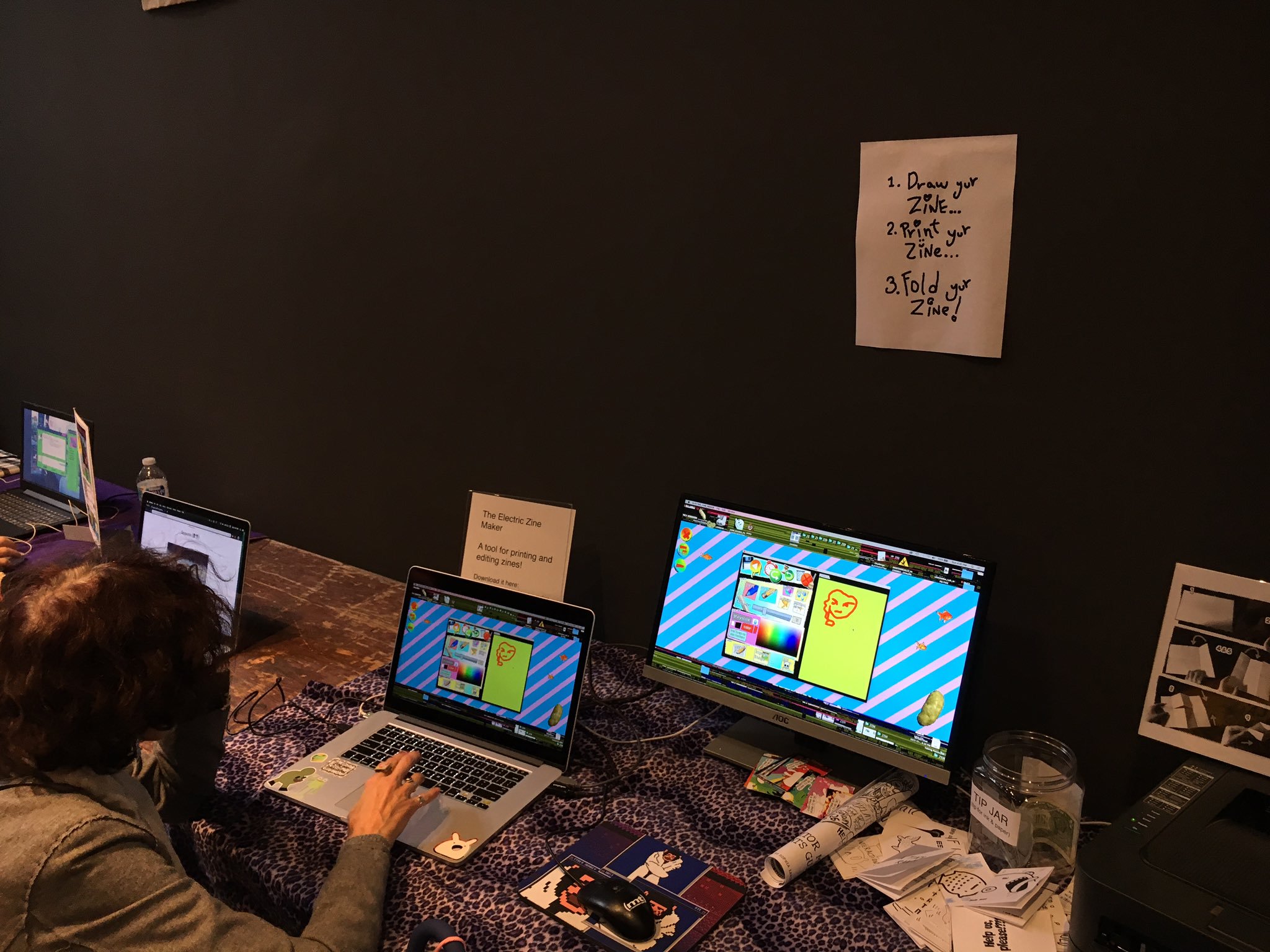
When I was showcasing the Electric Zine Maker at the LA Zine Fest (pre-pandemic, RIP social spaces) at one point a guy walked up with his group. They seemed casually interested by the bright colors, and the art that was going on.
When he realized that it was an app for making zines he said “Oh god, they made an app??” like he was disappointed, intimidated, shocked even, that someone made a “commercial” app for making zines. Like the app space was invading this sacred space, the last refuge to true unadulterated noncommercial art, that is zine making. He went on a little rant while him and the group walked away.
I REALLY appreciated the reaction tho. It’s one that I’ve been thinking about a lot lately, especially while making the Electric Zine Maker.
I know it was misunderstood because the Electric Zine Maker is probably as far away from commercialized software as you can get (I mean, look at the “official” website), but the fact that someone viewed apps in such a way (as an invasion) is really indicative to me of what software ended up meaning to the “everyday non-tech person”.
It’s a commercialized invasion. It’s Silicon Valley coming down on queer and art friendly cities, like San Fransisco, and gentrifying them into a shell of what they once were.
I think, in a lot of ways, the very first victim of Silicon Valley was actually software. This is my ranty hottake, by the way.
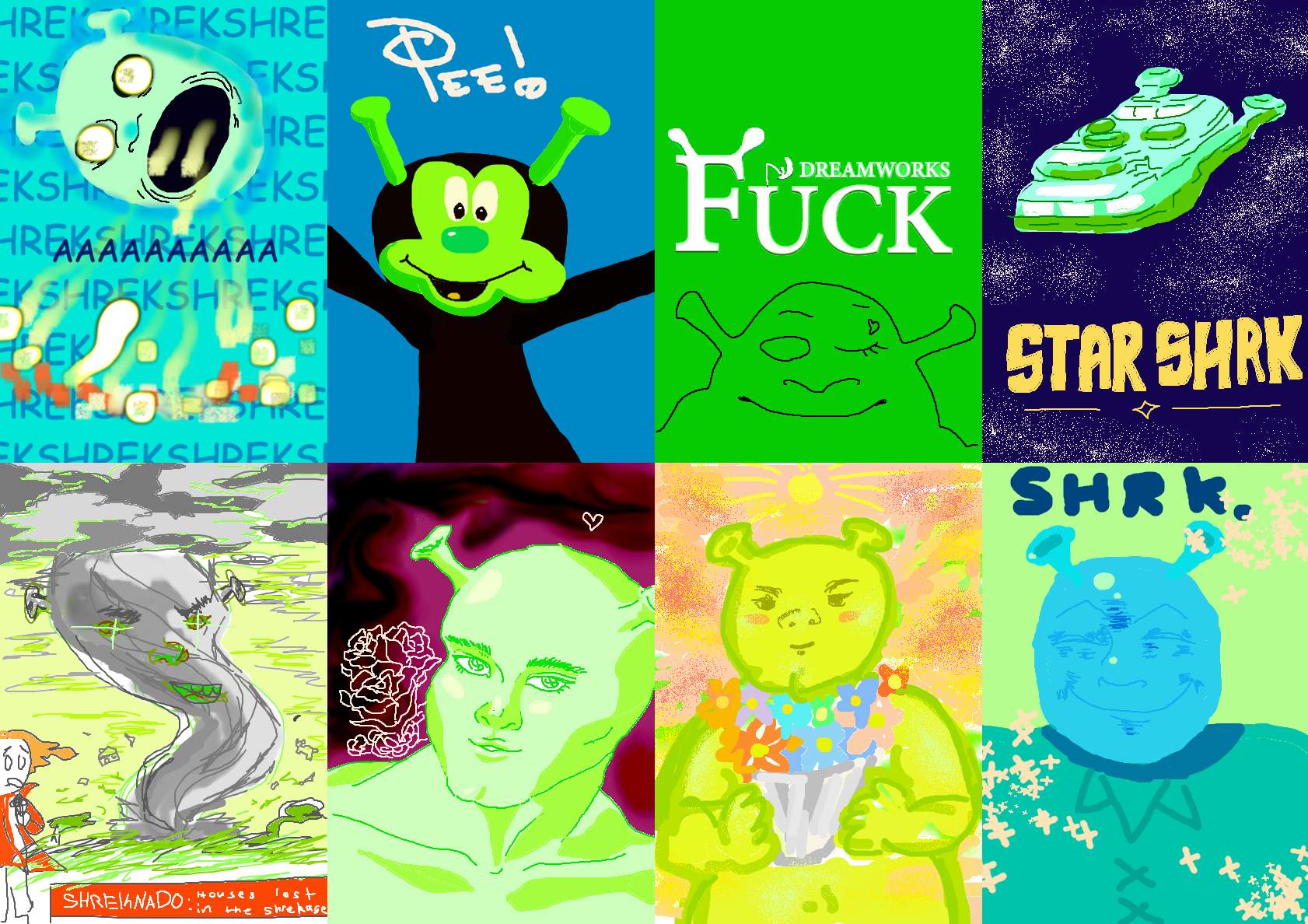
Images of the “Shrek Zine” made by a group of friends during IndieCade’s Night Games (pre-pandemic). Each one of them took a turn making a Shrek page in the Electric Zine Maker. xD Thank you.
Computer culture, and computer history, seems to be an unending push and pull between monopolies trying to monetize something, and people dreaming up ways to rebel against that. I remember when the internet was still new, and there was a vague window of dreaming that took place, where people much more rooted in anarchy and non-commercialism worked toward what the web could do or be.
It eventually became the social media hell that we have today, but before that… it was so much more to many.
I think software is the same way. It’s this amazing space of “small devs” tinkering, sharing, inventing ways to be creative using quirky interfaces, and sharing that the same way that you share zines. There always has been an aspect like that in the software world. We used to give out floppy discs with curated software on it.
Underneath all that hovers the ever impending gentrification of that freedom to develop and share. I find macOS’s gatekeeper, and that constantly tightening grip of “security” kind of terrifying for what it means to our future to freely share and create.
I mean, if you want a much more detailed history of this do read my “short history of Flash and the Flash website“, but essentially these spaces are constantly being commercialized under the guise of progress or security.
So, to me, software is also a victim of Silicon Valley. The spirit of just making and sharing software, without the looming “how will you get rich off this” hovering… Without the prerequisite of your software having to be distributed on the AppStore or Google Play, instead being freely shared outside of curated storefronts… Software just made outside of any market. Software is art too, and I think when you use art software made by smaller devs you are kind of making art inside of someone’s art.
That’s what the Electric Zine Maker is to me.
I mean, when you look at all the eccentric moving animated UI’s, and just that stylized chaos, it’s kind of the impression I hope you get. It’s something different, and you explore making something unique in that. It’s art that you make art in!
So like, going back to the LA Zine Fest, I feel like I’ve learned a lot from zine culture in terms of what it taught me about indiegames and software.
When you go to these zine events the first thing that strikes you is how non-commercial, feminist, queer, anarchist, socialist… it is. All that’s at the forefront. It absolutely is political.
Bellow all that is this underlying spirit of sharing art made for the sake of making art. The message, the politics… is something to be proud of. The imperfections are what make it so desirable.
It reminds me of why I got into making software, or even care about making games.
All art is fundamentally political. It’s impossible to separate art from the artist, or art from the environment it was made under. If you look at zine culture, it’s something you really get a sense of.
I think maybe if we viewed software making, and indie game making, the same way as zines are viewed, it would end up being really beautiful.
There was something grounding about seeing people seek out DIY art that’s as politically charged as it is imperfect.
While making the Electric Zine Maker, I’m constantly colliding with user expectations of what they want from software.
I truly appreciate feedback, don’t get me wrong I need it, but often there is a type of feedback that I find very difficult to parse (or accept?). Like when a person gets really aggressive about the menu looking a certain way, or that the colors are too colorful, and decides that I must hate people with disabilities. The font choices are too unreadable, I must be against dyslexic people… In many ways I think this comes from the “customer is always right” culture that tech fueled. Like the way people will yell at customer support in really verbally abusive ways because… well… software exists to serve them, and how dare it break?
It’s a difficult space to navigate if you’re making software that’s intentionally strange, loud, colorful… almost indifferent to the needs of the “end user” because the software exists also as art. Art is personal, so it can’t please everyone.
That’s kind of my take on all this. I don’t want to make a tool that’s perfect and aimed to please everyone. I want to make a tool that’s like zine culture. It’s unique.
I’m horribly dyslexic, by the way. It impacts my speech the most, but I struggle a lot with reading comprehension… Some of the font choices in some parts of the menus in the Electric Zine Maker were made because I have a hard time reading them, and found that exciting. It makes me feel alive the same way a roller-coaster does.
Maybe we can come to a point, in software culture, where we will seek out imperfections? Maybe we can even celebrate them, desirably, the same way as glitchart is finding its place?
Maybe (learning from zine culture) we can look forward to a future where the more political, the more “small”, imperfect, anti-commercial… your software or game is, the better. It’s one that I sure am ready for!
Ok, that’s my rant. Thank you for listening!
More reading about tools…
In other news…
I submitted the Electric Zine Maker to IGF, and have my fingers crossed.
I’ve been very busy working on an update that will bring a BUNCH of new zine templates. I hope to share more of that soon.
Edit: Adding this very cool writeup of Katelabs.
If you like how any of this sounds you can support me on Patreon or Ko-fi.
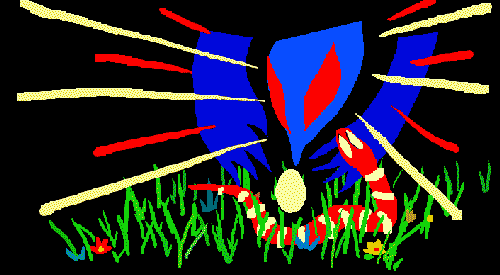
I really appreciate these write-ups/posts of yours about tools — I sometimes work on tools for smaller projects and try to think about ways in which they can be better or more natural for the specific person or people I am writing them for (admittedly, that’s sometimes me and in those cases the results are kind of less interesting). This isn’t really a scalable approach, it’s too idiosyncratic. But it often leads me to find interesting solutions to making the tools more approachable or more quickly to iterate with than I see in larger packages.
As larger indie spaces and even some of AAA coalesce around a few big game engines, it’s nice to see the more personal and expressive use of software that you showcase. And your side note about the first casualty of Silicon Valley being software really rings true to me; I think it’s such a cynical approach to software (and honestly, pretty much everything else), that I can understand the knee-jerk response of your EZM visitor at the fair. If you don’t work with software, or only use it to cynical ends, it’s easy to see it only as a tool of oppression and capitalism. It doesn’t have to be that. (Side note, and I don’t know if reading is really your thing based on your dyslexia, but I quite enjoyed Ellen Ullman’s collection of essays, “Life in Code,” which I think captures some of this feeling too.)
Anyway, thanks for doing such good work, I’d have a hard time having visibility into the things you cover otherwise.